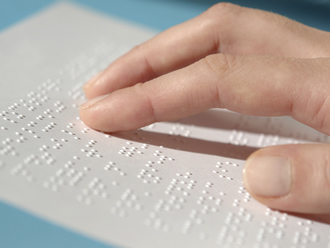What is the difference between all these Accessible PDF formats?
In the format world, an Accessible PDF file is a digital scan of a book or document that turns printed text into an electronic format. These files are readable on most computers or portable devices. AIM-VA provides four different types of Accessible PDFs when available. This month, these will be introduced so you know what the differences are, what programs students utilize and what some teaching ideas are that work with these files. Keep reading and find the answers to these questions and more.

These scanned files will look exactly like their printed counterpart and will maintain formatting regardless of screen size or magnification. PDF:Accessible files are the most readily available format created by AIM-VA.
Accessibility Features PDF:Accessible
- Provides an identical digital representation of a printed book.
- Compatible with text-to-speech programs.
- Can be opened by using a variety of programs on a computer and mobile devices.
- Can have the page size increased without distorting the text.
- Built in bookmarks for electronic navigation; acting as a “Table of Contents.”
- Most PDF readers will have a series of additional beneficial features such as:
- Highlights text as it is read for improved comprehension
- Contains note taking features like in text highlighting and commenting
- Bookmarking and electronic navigation

These PDF:FullyAccessible files are PDF:Accessible files that have been altered for additional accessibility. A PDF:FullyAccessible format does not look exactly like the printed book as it includes only content-related graphics, providing a cleaner, less distracting format.
Accessibility Features PDF:FullyAccessible
- Compatible with text-to-speech programs.
- Graphics and images that are provided are programmed with alternate text descriptions.
- Alternate text can be read aloud using text-to-speech programs.
- Font style matches the original text (i.e. bold, italics, underline).
- Page numbers correspond to the page numbers of the printed text.
- Footnotes are positioned within text to provide greater understanding of content.

PDF:ImageOnly files are a format that simply provides an image of each page of the PDF. This is often determined when text-recognition practices are unsuccessful. Yet, AIM-VA provides the PDF:ImageOnly file for those students who can read text independently and like to do so electronically and/or benefit from enlarged text when reading.
Accessibility Features PDF:ImageOnly
- Provides an identical digital representation of a printed book.
- Can be opened by using a variety of programs on a computer and mobile devices.
- Can have the page size increased without distorting the text.
- Built in bookmarks for electronic navigation; acting as a “Table of Contents.”

PDF:Publisher files are those deemed accessible by the book’s publisher and shared for distribution through the AIM-VA process. Some of these books have a limit on download and when reached, another request needs to be made by AIM-VA to provide additional copies/downloads.
Accessibility Features PDF:Publisher
- May or may not provide an identical digital representation of a printed book.
- Can be opened by using a variety of programs on a computer and mobile devices.
- Can have the page size increased without distorting the text.
- Most often built in bookmarks or actual Table of Contents for electronic navigation.
- Most PDF readers will have a series of additional beneficial features such as:
- Highlights text as it is read for improved comprehension
- Contains note taking features like in text highlighting and commenting
- Bookmarking and electronic navigation
Compatible programs that work with most Accessible PDF file formats
- Adobe Reader
- Text-to-speech programs such as: Kurzweil 1000 and 3000, Read&Write, KAMI
- Literacy software such as: WYNN
Teaching Strategies for use with all AIM-VA Accessible PDF formats
- While reading, use the Tools in Adobe Reader to Add a Comment, Insert Text, Highlight or Underline important information. Students can use the document to go back and study.
- If students aren’t going to have the internet available, they can use the PDF file in Offline mode: Kurzweil Education
- Students can type on the PDF file using text boxes to create sticky notes or text notes: Kurzweil Education
- Create a study guide: Kurzweil Education
| ePub | HTML | PDF: Accessible | PDF: Fully Accessible | PDF: Image Only | PDF: Publisher | RTF | Word/Google Doc | Braille | Large Print | NIMAS | |
|---|---|---|---|---|---|---|---|---|---|---|---|
| Page Layout | |||||||||||
| Like Original | X | X | |||||||||
| Varied | X | X | X | X | |||||||
| Text Format | |||||||||||
| Like Original | X | X | |||||||||
| Sans Serif | X | X | |||||||||
| Braille | |||||||||||
| Other | X | X | |||||||||
| Accessible Text (OCR) | |||||||||||
| No | X | ||||||||||
| Yes (Digital) | X | X | X | X | X | ||||||
| Navigation | |||||||||||
| Table of Contents/Bookmarks | X | X | X | X | X | X | |||||
| Headings | X | ||||||||||
| Page #s | X | X | X | X | X | ||||||
| Images | |||||||||||
| Displayed | X | X | X | X | X | X | |||||
| Alt Tags | X | X | X | X | |||||||







